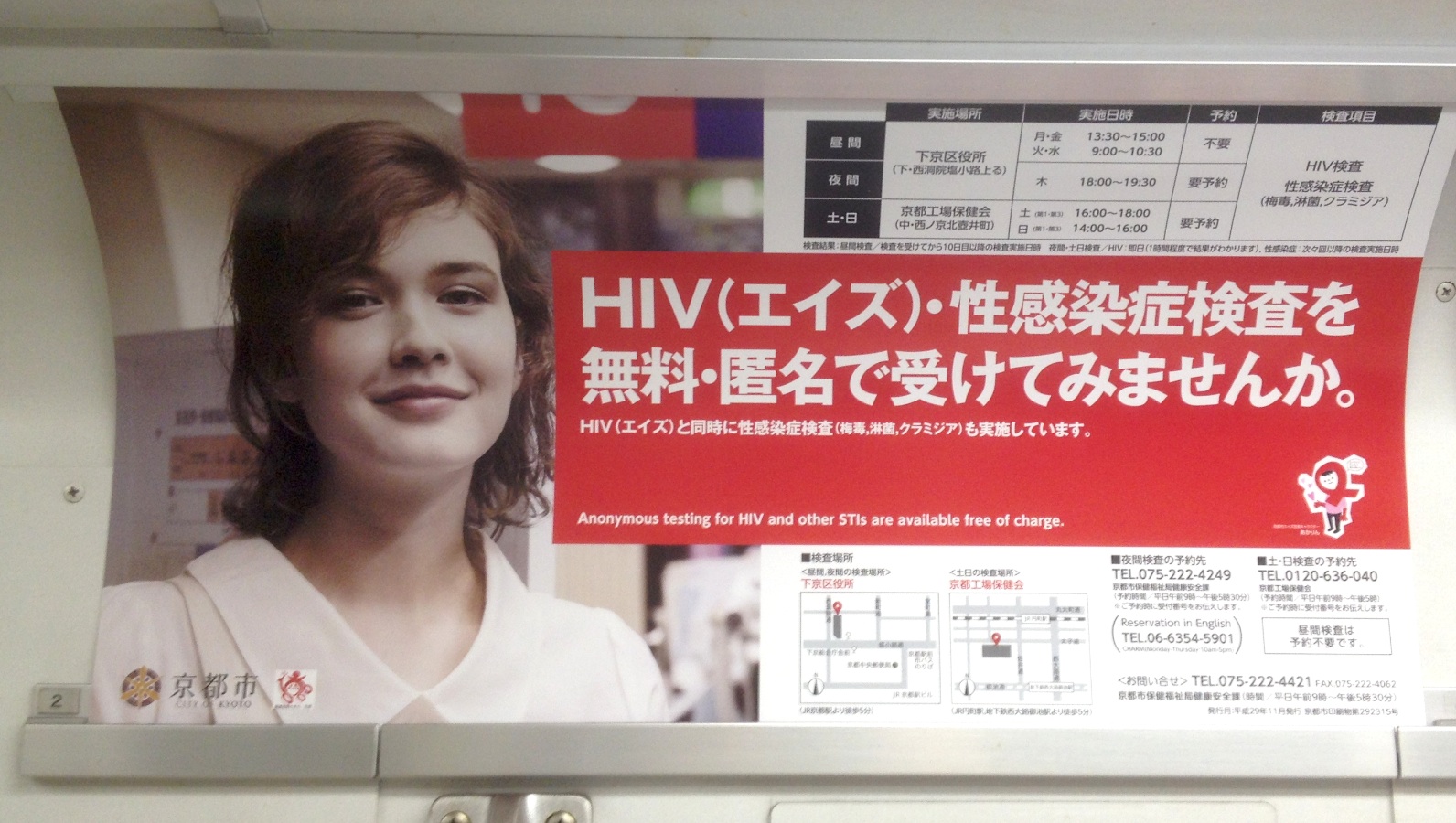mytest
Books, eBooks, and more from Dr. Debito Arudou (click on icon):





![]()


UPDATES ON TWITTER: arudoudebito
DEBITO.ORG PODCASTS on iTunes, subscribe free
“LIKE” US on Facebook at http://www.facebook.com/debitoorg
https://www.facebook.com/embeddedrcsmJapan
http://www.facebook.com/handbookimmigrants
https://www.facebook.com/JapaneseOnlyTheBook
https://www.facebook.com/BookInAppropriate
If you like what you read and discuss on Debito.org, please consider helping us stop hackers and defray maintenance costs with a little donation via my webhoster:

All donations go towards website costs only. Thanks for your support!
Hi Blog. Here’s a flashback to a time (dating from the mid-1980s, see here and here, for example) when people were saying that “foreigners have AIDS”. I was there; I remember it well.
The Kyoto Government is offering free AIDS and STD testing. Good. But check out what image they’re using for the face of sexually-transmitted diseases:
////////////////////////////////////////
From: XY
Subject: Embedded Racism, AIDS, and Sexually Transmitted Diseases
Date: March 8, 2018
To: debito@debito.org
Hello Debito,
Please see the attached photo, snapped on a Kyoto metro yesterday afternoon. The only non-Japanese face visible in the metro car (other than mine) is on an advert for AIDS and STD testing by Kyoto City Government. 
The poster seems to imply the foreign as the source of danger, illness, social decay. The (dyed? or at least not black) permed, and slightly disheveled hair accord with the stereotype of the western woman of lax morality.
I wonder whether they used a stock image or hired a model and whether the model was aware or consented to the use of her image in this context? While technically she is contributing to a good cause – increasing awareness of AIDS, STDS, and of a useful public health service, she most likely did not realize that her image also contributes to the construction and maintenance of negative bias against non-Japanese women.
I also wonder about the designers. Who decided to use a non-Japanese model and what was their rationale (or rationalization)? Japan as a multi-ethnic society, where non-Japanese can be employed for health service publicity? Or the purely functional message that the service itself is available for both J and NJ? How does it relate to the actual epidemiology of AIDS and other STDs in Japan? Does the poster reflect any reality in the situation or is it a complete misrepresentation of the epidemiology?
Cheers and keep up the good work. Sincerely, XY
////////////////////////////////////////
COMMENT: Now, some might argue (and believe me, pedants, naysayers, and White Samurai will) that this is merely an IStock photo and that there was no association meant. But that’s not how advertising works. (Why add an image of a person at all if that were true?) Others might say that she’s representing a medical professional pleased to see people coming in for testing. But there is no context grounding that, either. (No clear nurse’s uniform, nor a background that is clearly a hospital. It looks more like a government front desk area to me; if you look closely at the poster, that’s in fact where the testing is happening, not at a hospital; she’s a patient, not a government representative.)
Again, why are we targeting a Visible-Minority demographic with this ad? As XY says, that’s the embedded racism of this campaign.
My suspicion is that they are targeting Japan’s sex workers, and a frequent association is that any foreigner imported for this task has diseases. This poster merely fortifies that.
And, to answer XY, it’s wrong. According to the National Institute of Infectious Diseases, in 2015, non-Japanese people accounted for the minority of 108 (88 male; 20 female) out of 1,006 AIDS cases in Japan (and homosexual men, not women, remain the largest affected demographic). Plus don’t forget that historically, a significant number of AIDS cases in Japan were the result not of sexual contact, but of HIV-tainted blood recklessly given to hemophiliacs by the Japanese government in the late 1980s. That’s why this poster is visually misrepresenting the issue on many levels.
As XY also notes, I wonder what the model herself thinks about being associated with sexually-transmitted diseases? I wish we could ask. Dr. Debito Arudou
==============================
Do you like what you read on Debito.org? Want to help keep the archive active and support Debito.org’s activities? Please consider donating a little something. More details here. Or even click on an ad below.
22 comments on “Kyoto City Govt. subway advert has Visible Minority as poster girl for free AIDS/STDs testing. Wrong on many levels, especially statistically.”
Yeah, really if they want to raise awareness they should have a dead normal Yamato nadeshiko with small nose, and long straight black hair, you know, like all the really ‘normal’ looking japanese women in adverts.
Or better still, a middle-aged salary man who has been to soaplands with his boss and is going to take HIV home with him and infect his wife.
Sheesh, denial is a national sport in Japan.
— But let’s get the narrative correct. Extrapolating from the statistics, the majority of HIV cases in Japan probably don’t come from soaplands.
Yeah, actually you’re right, my bad.
J-businessmen perusing and carousing a red light district in Bangkok might have been a more apt picture. Hey, and theres even a foreign element to that to keep the nationalist/purists happy! (irony).
They should include HPV awareness in the campaign as this leads to cervical cancer, but it seems the number of women getting regular smear test in Japan seems quite low. As this is so easy to transmit even with condom usage I believe, only testing can help.
Lets contact them and see what they have to say for promoting a dishonest representation of the most likely person in Japan to have HIV. It should have been a Japanese man, going by statistics. Why this inflated fear of caucasian girls?
Anyone got the city hall email address?
Ahh, flashbacks to the early 1990s. Anyone else remember the poster/magazine ad featuring the Japanese business man covering his face with his (oversized) passport and the caption “Enjoy your trip but beware of AIDS”
Yes, it’s problematic. It places an image of a visual minority – with no context – in proximity to the words HIV and AIDS.
Meanwhile chlamydia and various other STIs are rife, but could easily be prevented with condom use. Why not a campaign against them as well?
I remember the early 90s too Andrew, it was all “Foreigner= Aids” and not really a Japanese problem.
Because We Japanese are different.
Similarly,Fukushima radiation is different from other, foreign radiation too. Nothing a few dandelions cant stop….or not. Even in Saitama, but I digress into Pythonesque irony.
http://fukushima-diary.com/2012/04/farm-gets-full-of-mutated-dandelions-in-saitama/
I don’t believe they’d use a picture of a Japanese person for this kind of ad.
As far as I know, Japan doesn’t stereotype Japanese in a negative manner.
If they didn’t use a foreigner they probably would have used a character or just plain text.
It’s unfortunate that the submitter did not inform you that these ads are always deployed in pairs, with a “female” and “male” version. The male version features a young man who appears in all ways to be typically Japanese. Just so you and your commenters know that yes, they do also use a clearly Japanese person in the same campaign.
— Let’s have a picture of it, then. Please send to debito@debito.org
Be happy to, if I happen to end up on one of the subway cars where the ads are displayed. But maybe the original submitter could comment on this point? It’s quite literally impossible to see the female version without the male version — I have seen the posters on the subway dozens of times and they are *always* posted in pairs.
— Thanks.
Good job for pointing that out
With regards to ‘Kyoto Joes’ objection: there is indeed a male version of the advertisement. The model is of East Asian descent, however is not certainly ‘a clearly Japanese person’ – he may or may not be Japanese.
Either way, how does this change the gross mis-representation of the demographics of AIDS through the use of a model who is clearly non-Japanese?
— Let’s have a photo of the second sign so Debito.org Readers can judge for themselves!
I’ll leave that to ‘Kyoto Joe’ since I am not often on the subway.
It changes things completely in that it calls into question the entire idea that non-Japanese are being *specifically* targeted in this situation.
There is some unfortunate irony in all this, in that the onus has apparently been shifted onto *me* to prove that these advertisements are not racist, discriminatory, or otherwise stereotyping in nature, when really it is the person who lobs accusations of such discrimination that bears the responsibility to demonstrate clear malicious intent. If you are going to accuse an entity of racism then you have an ethical obligation to, at the very least, do your own due diligence and make some sort of good-faith attempt to corroborate the information.
— Fair enough. Point taken. But you ARE making a claim that there is another poster, so the onus is on you to substantiate that. Get a photo, please.
Does Kyoto Joe need a lesson in elementary statistics? We have one clearly NJ face and one face that may or may not be Japanese. Is this not a gross mis-representation of the demographics of AIDS in Japan?
And as I think Debito will attest, racism is all about bias, bad statistics, and inaccurate representation of demographics.
Intentional or not, racial bias is present in the use of minority models for the Kyoto AIDS testing campaign.
The second poster does not change that one iota.
To YK: I’m sorry, but no. And your actions prove this.
Like I said, I’ve seen the advertisements on the subway so many times I can’t count, and the posters are always displayed in pairs. You yourself have admitted that you saw the male version, but you didn’t send a photo of it as well. I have to say, the fact that you excluded the male version is highly suspect to me. At the very least, it was a careless omission on your part. Perhaps, though, there was a reason why you decided not to send the male version too. Perhaps it called into question the narrative being promoted here — that the signs are unfairly portraying AIDS as specifically a “foreign” problem. I’d say that if it’s reasonable to assume, as you seem to think, that Kyoto City had malicious intent with these signs, it’s equally reasonable to assume that you had similar intent by omitting the male version.
The male version is essential because, as I said, it changes the entire idea that this advertisement was somehow designed specifically to target foreigners. On the contrary, the existence of the other poster proves that Japanese people are clearly at least part of the target audience. All this can be reasoned even without actually contacting city hall or whatever party was in charge of commissioning the advertisements — but even if you don’t accept the logic of that thinking, ethics and due diligence dictates that you contact city hall first to clarify the situation before deciding that this is absolutely discriminatory and making actual accusations.
There’s more sloppy thinking here, too, though. You have said that the male version “may or may not” be a Japanese person. Yet at the same time, you feel 100% confident that the female version is not Japanese. There’s a contradiction there. You seem to be trying to apply two different (and apparently arbitrary) standards to the posters to judge the “Japaneseness” of the subjects. Can you tell me what, exactly, leads you to think that the female version depicts a person who is clearly not Japanese, whereas the male version is decidedly ambiguous? I’d wager you can’t.
(All this is, of course, setting aside the idea of Japaneseness as something that can be identified visually, a concept central to Debito’s work for years.)
It’s funny, too, because on the subway today I noticed a Kyoto City-produced sign admonishing people for bringing large bags and suitcases onto the crowded subway. Kyoto is jam-packed with tourists and this is a huge problem (I speak from experience) — and it would have been totally reasonable for the ad to depict tourists in its warning. On the contrary, the offender with the massive rucksack was a Japanese high school boy. So it would appear that Kyoto City is not completely dead-set on accusing foreigners of all Japan’s problems — even when foreigners actually are the cause of some of these problems. 🙂
(Incidentally, I’ve been looking for the posters but they are nowhere to be found now. I’m assuming the schedule ran its course.)
The female model, even if she holds Japanese citizenship, which I never stated is not a possibility, appears foreign and would be treated as a minority in Japanese culture.
Even taken as a pair (minority female, more representative male) this is a far from statistically correct representation of the demographics of AIDS in Japan. Therefore it exhibits racial bias. The male poster is not needed to prove the point.
This is not a blanket claim that City Hall is always racist, or essentially racist. Much more would be need for that. It is just a factually based observation of racial bias in an advertising campaign initiated by City Hall.
The rest is your imagination.
Dear XY, by not posting a pic of the male version of the poster, IMHO, you are the one with a bias here. Your post here on Debito.org is fake news, as it seems. For me, one male, one female, one foreigner, one Japanese gives a clear message that anybody can get AIDS. There is no need for statistical analysis here.
Wow, some posters will go to any lengths to excuse backwards official attitudes and behavior in 2018 Japan.
It’s the 21st century, not the Tokugawa Closed Country period, so yes we can criticise biased and racist propaganda no matter how much it seeks to disguise itself.
The Japanese 98 percent majority argument cuts both ways. The Japanese Govt and many of its citizens always play that card to differentiate themselves from outsiders and to assert that we outsiders have to suck up whatever comes our way. Without being so honest about it.
A society that has an overwhelming majority of Japanese people will have the overwhelming majority of cases of sexually transmitted diseases including ones from HIV.
As for the small official numbers of people in Japan infected with HIV – read with cynicism. That is a carefully selected statistic. Given the scale of the sex industry here and the normalisation of buying sex and not having protected sex whether paying for it or having it for free, there are more than likely much higher numbers.
In the final analysis, official Japanese propaganda is in one way irrelevant. This society does so much damage to itself by such attitudes.
By 2050 Japanese society as it is at present will have ceased to exist. The demographics do not lie – the current low birthrate can only be countered if Japanese women of childbirthing age start having at least 3 children. That isn’t happening in any universe, this one or parallel.
Based on hard facts, it would take Japan around 50 years to heal its dreadful demograhics – and that would assume all Japanese women who are able, will have 3 children each. It’s not happening.
The official racist claptrap and other nonsense is irrelevant not too far down the track. Suck it up, Japan.
Debito.org Reader “The Butcher” writes:
Debito, Re Kyoto AIDS poster:
Both photos are included in this PDF on page 15:
http://www.city.kyoto.lg.jp/templates/shingikai_kekka/cmsfiles/contents/0000238/238391/300327.pdf
There doesn’t appear to be larger versions online.
I tried to post but my company’s proxy server is blocking my ability to do so.

Best regards, enjoyed the discourse …
Hmm, that “Japanese” guy has brown hair. And as we all know, Japanese don’t have brown hair (see high school hair dying rule enforcement).
bad move; brown hair = “furiyou” or “fumajime” and therefore deserving what he gets…will be the mindset of certain prim and proper delusional readers in Japan.
There was a case in a textbook many years back about a Japanese truck driver being fired for dying his hair brown; his boss blamed “American influence”.